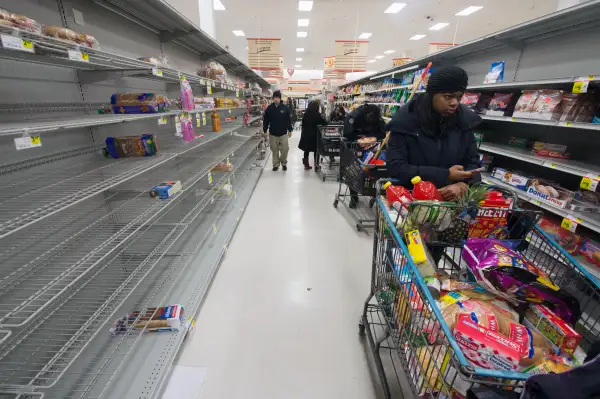Panic Shopping! How a Blizzard Turns Us into Irrational Hoarders at the Grocery Store

Almost exactly a year ago, supermarkets cashed in as shoppers rushed in and ransacked store shelves in anticipation of snowy weather and the polar vortex's subzero temperatures hitting a broad swath of the country. This week, it's largely the same story in the Northeast, what with a historic blizzard said to be threatening New England and much of the Mid-Atlantic region.
Over the weekend, the panic hoarding began, with shoppers emptying grocery store shelves and grabbing every last loaf of bread, carton of eggs, and bottle of milk in sight. On Sunday, shoppers at one New Jersey supermarket reported it being nearly impossible to find a parking spot outside the store, while inside the scene was one of empty coolers where milk used to be, employees fighting through crowds to restock shelves, and endless lines snaking away from cash registers. Likewise, shoppers have been sharing photos of the crazy mob scenes over the weekend inside grocery stores in Boston, New York City, and elsewhere with #Snowmaggedon2015, #Blizzardof2015, or whatever your preferred nickname is for the storm.
By now, this kind of pre-storm mad rush at the supermarket is to be expected. Heck, it's far more reliable than the actual weather forecasts ever are. And to some extent, this behavior is reasonable. We're relentlessly instructed to take precautions, prepare for the worst, go the route of better safe than sorry, and … you get the gist. You don't want to be stuck in a blizzard without a shovel or enough food to last for a few days, after all.
Yet, as with so many other things involving human beings, there's a tendency to go completely overboard. What starts out as a prudent and sensible shopping excursion can quickly devolve into a frenzied, agitated exercise in hoarding at an overcrowded supermarket or hardware store, as the ugly, primal side of humanity rises to the surface.
During the polar vortex of early 2014, for instance, some supermarket customers reported that meat and bread were swiped from their shopping carts while their backs were turned. Ever since Superstorm Sandy left gas stations without gas and led to some instances of price gouging where gas was available, drivers have been known to flock to the pumps to fill up when a big storm is in the forecast. Far more often than not, of course, it's wholly unnecessary to wait in line for 30 minutes or longer just to top off your gas tank.
What is it, then, that pushes us over the edge? Why do shoppers head out to the store in preparation of some snow and perhaps a couple days without power, and then they (OK—we) wind up hoarding all manner of goods as if preparing for the apocalypse?
Part of the explanation is mob mentality. When we see others streaming into stores and snatching up perishable goods by the cartload, we feel pressure to do the same. Perhaps, we think, these crazed shoppers all around us know something we don't? It's easy to see how this mentality snowballs—excuse the pun—when an epic blizzard is expected. This kind of thinking also pushes consumers into the realm of irrationality on days like Black Friday, when the bustle of crowds and competition causes people to overreact and buy things they wouldn't have had there not been dozens of shoppers fighting to get their hands on some supposedly hot, must-have holiday purchase.
Consumer psychologist Kit Yarrow, an author and frequent TIME and Money contributor, explained via email that no matter if it's Black Friday or the day before a blizzard or hurricane is about to hit, when crowds descend on stores we essentially revert to cavemen. "Clearly we’re responding to emotions and crowds, and our brains are a few steps behind," said Yarrow. What else could explain the act of rampaging through the supermarket and "greedily grabbing the last can of Spam"?
"It starts with a normal impulse to stock up on things that might not be available for a few days," Yarrow said. "Panic hits when the stores are jammed with other shoppers and the shelves look a little bare. It’s not so much a thought as it is an impulse that hits, and it’s associated with the caveman parts of our brain that take over when we perceive we might be in physical danger. We are prewired to fight for food when we sense that resources are scarce."
Afterwards, we're likely to look back on our behavior with puzzlement, and perhaps embarrassment. "Shoppers are going to find that canned food in the back of their pantries someday and wonder what they were thinking," said Yarrow. "The fact is, they really weren’t thinking. Primal brain took over."
Try to keep this in mind when, inevitably, the next "historic" storm is on the horizon and your supermarket seems to have been invaded by hoarding barbarian masses. By then, however, it'll probably be too late. You'll be in the store, not thinking, and instead following the primal impulse to race to get the last loaf of bread before it's gone.
Speaking of which, anyone have any good recipes that involve Spam? Somehow, I have a bunch in the pantry, though I don't remember even buying them.
